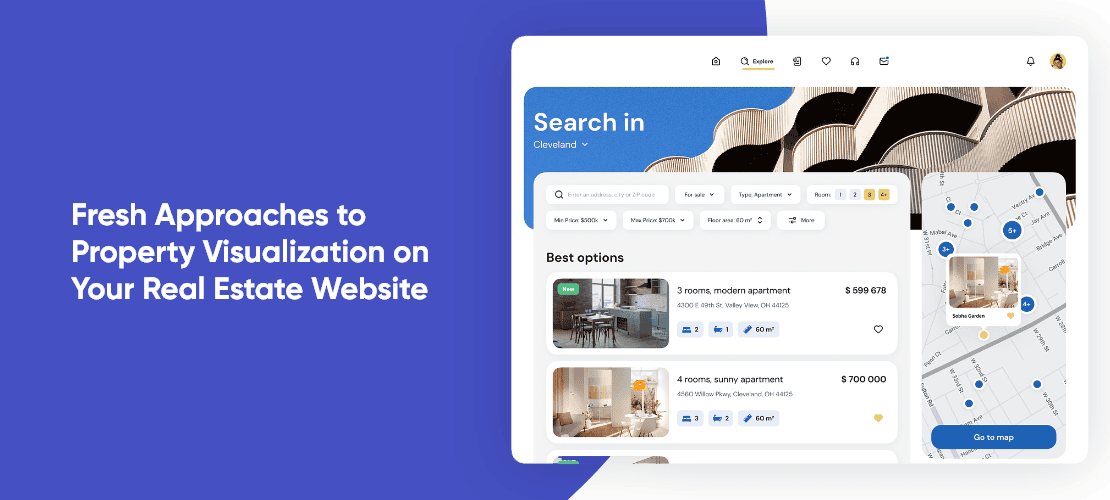
- October 25, 2024
- Reading time about 5 minutes
Many realtors are offering virtual tours on their listing management platform. Convenience has been on the minds of homebuyers for a long time now. Realtors have adapted accordingly and worked hard to offer ease through their real estate website. But the real question is—Are they doing enough?
Potential buyers are looking for further innovations to assess the properties sitting on their living room couch. With user experience taking center stage, the real estate sector is under tremendous pressure to find new ways to make property viewing and visualization more interactive. Map-based searches have gained massive popularity in recent years owing to the visualization they offer to homebuyers in assessing the neighborhood.
Let’s take a closer look at the role of geospatial data in effective listing management and a great closure rate.
Role of Geospatial Data in Effective Property Visualizing
Geospatial data helps users know where a property is and what’s happening around it. When you search for the location of a restaurant near you, it’s geospatial data in action. You can visualize geospatial data through maps, 3D models, and other GIS tools.
Geospatial data makes all the difference in the real estate landscape, adding a whole new dimension to property listings. It allows real estate professionals to give potential buyers and investors a bird’s-eye view of exactly where the property is in a broader spatial context, thus allowing them to make more accurate decisions about any location.
It’s not all conceptual. Businesses that have incorporated geospatial data on their real estate websites have experienced a 5% increase in retention rates. When website visitors are well engaged during their listing browsing, they tend to stay for longer, increasing the likelihood of lead generation and conversion.
Now that homebuyers have become quite acquainted with virtual tours and interactive map integration, realtors are on the lookout for fresh approaches that can allow them to showcase properties in more engaging ways.
How to Showcase Properties in New Ways on Your Real Estate Website?
Potential homebuyers are interested in knowing two types of geospatial data—property search or neighborhood exploration. You can address both interests by integrating advanced property display and map-integration features on your real estate website. Let’s have a look at how to do that.
1. 3D Visualization of Properties
Once a potential buyer shortlists a property, they can be offered to visualize the property in 3D using a location highlighter. By using this feature, they can see the property outline in the context of the neighborhood. This will help them understand the property view. You can further enhance their experience by offering options to rotate, drag, zoom, and pan the map.
An advanced real estate website builder like BidHom allows you to offer such visualization options to your potential clients.
2. Map Customization for a Better Experience
Don’t just stick with basic map views but go for customization that is specifically tailored for the real estate sector. There can be different map types that you can integrate with your website. You can choose from satellite imagery, 45-degree, terrain, or customized.
The ideal map view for real estate websites is the one that comes with point-of-interest (POI) categorization. Real estate-specific map views must display nearby schools, malls, hospitals, and other amenities for potential buyers to assess the neighborhood easily.
3. 360-degree View for an Immersive Experience
Imagine offering your potential clients a real-world 360-degree view of properties! It will help them consolidate their decision in real time and move the deal further in the funnel.
The dynamic street view takes the imagery to a new level, leaving potential homebuyers in awe of the property they have been eyeing.
4. Local Highlights as Decision-Making Aid
Allow potential homebuyers to have a comprehensive look at the local amenities nearby property through an exclusive tab. Show them the proximity to important places like schools, clubs, hospitals, and community parks so that they have a clear picture in their mind of the neighborhood before they decide.
Allow them to filter their search using keywords and get more accurate results, or let’s just say—get them what they want to see.
5. Distance Matrix for Easy Commute
Don’t just stop at giving them local highlights. It’s the distance that plays a huge role in whether they will purchase a property or not. Implement a robust distance matrix to calculate the travel time and best routes for them to consolidate their decision. This feature will allow them to know the travel time to the nearest grocery store, church, or hospital.
Also, you can incorporate a traffic overlay that can inform them about the traffic conditions in real-time.
These new approaches to property displays and map integration will give a unique selling point to your real estate business. An IDX website for realtors must be power-packed with such immersive experiences so that potential clients don’t abandon their browsing journeys in the middle and continue to spend more time on the website.
Allow BidHom to Take Care of Search Experiences
When you invest in an advanced listing management platform like BidHom, you don’t have to worry about such innovative property highlighting as a standalone aspect. BidHom is a leading real estate website builder that integrates map search and property visualization in the most engaging ways.
With extensive experience in building custom, white-labeled platforms for agents and brokers, BidHom understands your need to put user experience at the top of the list and incorporate features that truly capture the interest of potential clients.
Want to know more about how we can enhance your website’s property display capabilities? Book a demo today.


